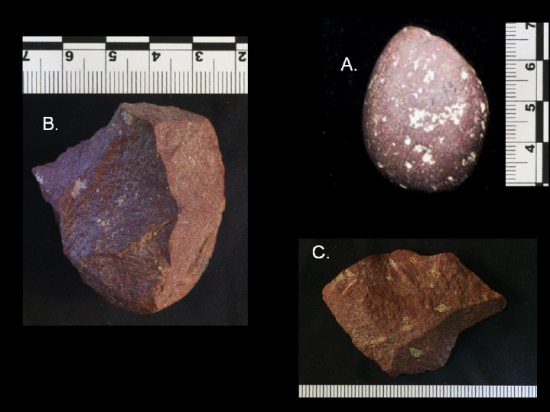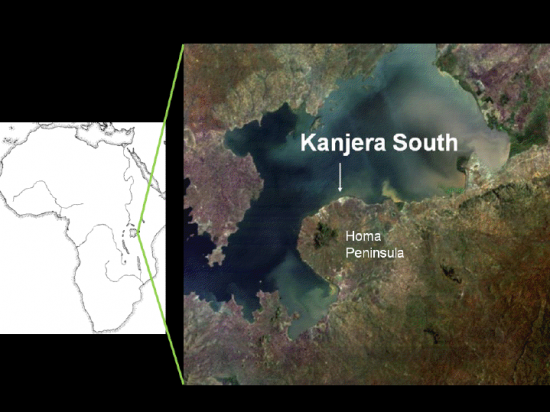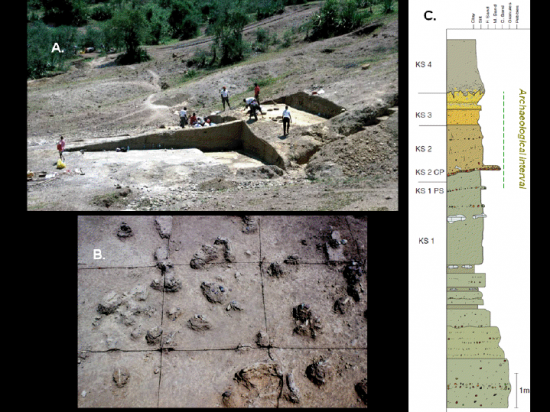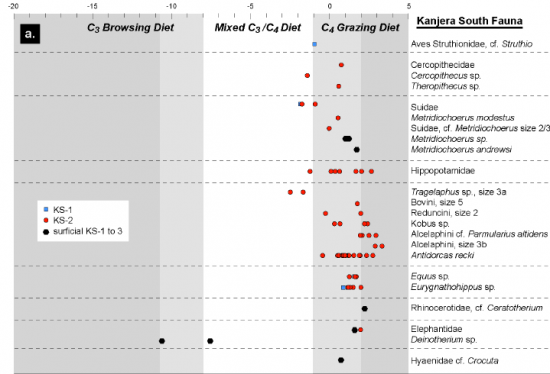Tom Plummer
Source - http://popular-archaeology.com/issue/june-2012/article/the-hard-stuff-of-culture-oldowan-archaeology-at-kanjera-south-kenya
Discoveries in southwestern Kenya by pioneering scientists are now opening new windows on humankind's earliest stone tool industry and expanding our understanding of early human behavior and the evolutionary past.
The material culture of humanity litters our world. The residues and trash of past civilizations fill up museums, and have provided the fodder for countless dissertations. From an evolutionary perspective, much of the variation in human cultural practices is “noise;” it does not provide a significant adaptive advantage or disadvantage to the population in question. But the capacity for culture, and the use of culturally derived technologies, behavioral practices, and social institutions to adapt to varying environmental circumstances has been a critical part of humanity’s success.
Whereas other primates (e.g., the living great apes, and some populations of capuchin monkeys) may exhibit culture, and produce technologies that assist in foraging, humans are unique in being dependent on cultural practices for survival. But how far back in time does this dependency on culture go? The oldest evidence for material culture in the human family tree extends back to nearly 2.6 million years ago (Ma) in Africa. Stone tools found at sites dated roughly between 2.6 and 1.6 million years ago are attributed to the Oldowan Industrial Complex, named after the type site of Olduvai Gorge, Tanzania (Plummer, 2004). Oldowan archaeological sites are restricted to East Africa between 2.6 to 2.0 Ma, and thereafter are found in North and South Africa. In the Oldowan, large pebbles, cobbles, or angular blocks of stone (cores) were struck with another rock (a hammerstone) to detach flakes that had sharp edges and could be used for a variety of cutting tasks (Fig. 1). Large mammal butchery was one demonstrable use of the artifacts, as cut marked bones are coeval with the oldest stone tools, but they may have been used to work wood and process plant foods as well.

Figure 1. Oldowan artifacts from Kanjera South made from red felsite. A. Hammerstone. B. Core showing flake release surfaces. C. Flake. Photo credits: Jim Oliver and Tom Plummer
One of the primary goals of my research is to investigate the adaptive significance of Oldowan tools. Were stone tools a critical part of the foraging ecology of early humans, or were they only used incidentally, or seasonally, more akin to chimpanzee tool use? It is likely that more than one species of early human used Oldowan tools, including two members of the human genus Homo, named Homo habilis (ca. 2.4 – 1.4 Ma) and Homo erectus (ca. 1.9 – 0.2 Ma). Understanding how Oldowan stone tools were manufactured, transported, used, and discarded across the landscape will tell us something fundamental about the behavior and cognitive sophistication of the oldest stone tool makers, and the importance of tool use and manufacture to their lives. Although not abundant, there are a growing number of Oldowan sites from Africa. Here I will be describing on-going research from sites in roughly the middle of the timespan for the Oldowan, from the Homa Peninsula, southwestern Kenya.
The Oldowan Site of Kanjera South, Kenya
Since 1995 I have been co-directing research on the Homa Peninsula in southwestern Kenya with Dr. Richard Potts of the Human Origins Program of the Smithsonian Institution, working with an interdisciplinary team of paleontologists, archeologists, and geologists investigating the late Pliocene and Pleistocene deposits exposed there (Behrensmeyer et al., 1995; Bishop et al., 2006; Braun et al., 2008, 2009a,b; Ditchfield et al., 1999; Ferraro, 2007; Ferraro et al., ms; Plummer et al., 1999, 2009a,b). The Homa Peninsula juts into the Winam Gulf of Lake Victoria. Centrally located on the peninsula, the peaks of the Homa Mountain carbonatite complex are ringed by sediments deposited by streams and lakes as well as alluvial fans off the flanks of the mountain. Fossil-bearing sediments extend back in time to at least 6 Ma, with the oldest well-dated archaeological occurrence being found at Kanjera South (Fig. 2).

Figure 2. Location of Kanjera South on the Homa Peninsula, Winam Gulf, southwestern Kenya.
Based on magnetostratigraphy and biostratigraphy, the archaeological sites at Kanjera South are approximately 2 million years old. Excavation through silts and fine sands from an ephemerally flowing system of small, shallow channels in the margins of an ancient lake has recovered multiple levels of stone artifacts and associated fauna through three beds (from oldest to youngest KS-1 through KS-3) spanning several meters of sediment (Fig. 3) (Plummer et al., 1999).

Figure 3. A. Excavation 1. B. Artifacts and fossils being recovered during excavation. C. Composite stratigraphic log shows the basal three beds of the Southern Member of the Kanjera Formation (KS-1 to KS-3) and the base of KS-4. Spatially associated artifacts and fossils are found as diffuse scatters and also in more vertically discrete concentrations from the top of KS-1 through KS-3, with KS-2 providing the bulk of the archaeological sample. Photo credit: Tom Plummer
Except for several discontinuous conglomerate units, hominin activity was the primary agent of accumulation of the Kanjera archaeological materials (Plummer et al., 1999; Ferraro, 2007). The 169 m2 Excavation 1 is the largest excavation to date, and has yielded approximately 3700 fossils and 2900 artifacts with 3D (N, E, and Z) coordinates from a one meter thick sequence, exclusive of materials from spit bags and sieving. This represents one of the largest collections of Oldowan artifacts and fauna found thus far.
The Environmental Setting of Hominin Activities
The habitats that were available to hominins, and whether they preferred a specific habitat or utilized a range of habitats, are important to document to understand their adaptation. Over larger timescales and geographic regions, patterns of environmental change can be related to patterns of hominin (living humans and related fossil species) evolution to investigate whether environmental change triggered evolutionary change (DeMenocal, 1995). It seems likely, for example, that the spread of grassy environments played an important role in transformations in the human evolutionary tree through time. Early in our excavation it became apparent that the faunal signal from Kanjera South was more “open” than is typically associated with early archaeological sites. Antelopes whose living relatives are found in open settings today dominate the bovid sample, and fossil zebras are also common. This fauna indicates that grassy habitats were well represented within the regional plant paleocommunity. On a more local scale, analysis of the chemistry of soil carbonate nodules associated with the archeological horizons provides information about the vegetation cover (proportion of grasses using the C4 photosynthetic pathway versus plants such as bushes, shrubs, or trees using the C3 photosynthetic pathway) at the time that hominins were making, using and discarding stone tools at the site. The Kanjera soil carbonates have δ13C values indicative of a very grassy setting (> 75% grass) within the range of open habitats such as wooded grasslands to open grasslands today. Stable carbon isotope analysis of enamel indicates that these taxa uniformly had a large amount of grass in their diets, reflecting the dominance of grass in the vegetation community (Fig. 4).

Figure 4. Stable carbon isotopic composition of fossil mammal tooth enamel from KS-2 in Excavation 1. The KS-2 fauna is supplemented by several taxa unique to KS-1 or KS-3, or found on the surface of the KS-1 to KS-3 sequence, to provide a more complete sense of the diet of the mammalian community during the deposition of the archeological levels. The shading reflects the relative importance of C3 browse versus C4 grass in the diet, with δ13C values greater than -1 reflecting a diet with more than 75% C4 vegetation. A probable ostrich (cf. Struthio) eggshell fragment was also analyzed. Modified after Plummer et al. (2009), Figure 3.
This is true even for taxa that normally have a C3-rich (fruit or browse) diet (e.g., tragelaphine antelopes and the monkey Cercopithecus sp.). One of the two teeth from Deinotherium, an elephant-like creature that normally exclusively browsed, has the most positive δ13C value ever documented for this taxon indicating that it at least occasionally consumed C4 plants. The strong C4 signal occurs across the spectrum of animals found at Kanjera South, including non-dispersing taxa such as monkeys, rhinos, tragelaphine bovids, and suids. This confirms that the grassland dietary signal is not simply the result of dry season domination of the residential mammalian community by migratory grazers congregating near a permanent water source.
The ca. 2.0 Ma sediments at Kanjera South thus provide some of the best early evidence for a grassland dominated ecosystem during the time period of human evolution, and the first clear documentation of human ancestors forming archaeological sites in such a setting. The presence of artifacts and archeological fauna both low and high in the KS-2 sequence and in the underlying KS-1 and overlying KS-3 indicates that hominins repeatedly visited this grass-rich area on the landscape for hundreds or even thousands of years. This is significant for several reasons. The open setting contrasts with the more wooded settings associated with other Oldowan sites. This suggests that by 2 Ma, the hominins forming the Oldowan sites were utilizing a broad spectrum of habitats during their foraging. Activities in open settings may have correlated with hominin utilization of plant or animal resources that were specific to those habitats. Moreover, the formation of sites in an open setting provides one line of evidence that hominins, in at least some paleoecosystems, were able to compete effectively with large carnivores. This is an important finding, as there is clear evidence that Oldowan hominins were consuming animal carcasses, and this dietary shift would have increased the frequency in which hominins and carnivores came into contact, perhaps in competition for the same carcass.
PART.2